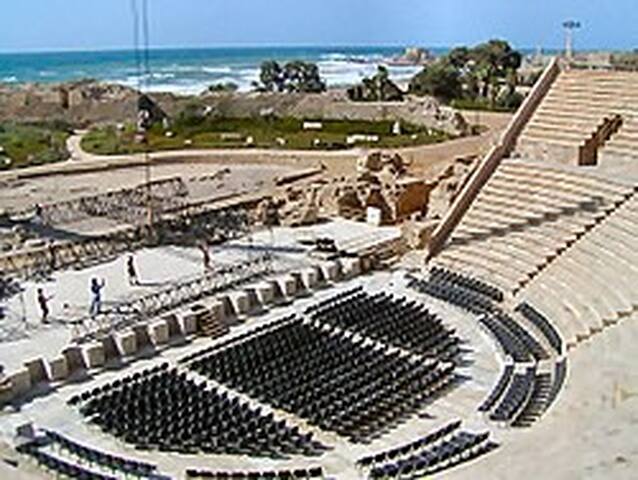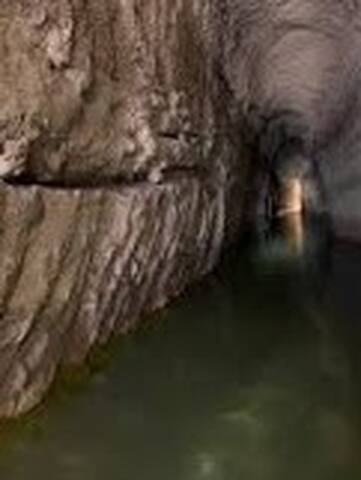אתרי תיירות
Caesarea (/ˌsɛzəˈriːə, ˌsɛsəˈriːə, ˌsiːzəˈriːə/), named in Hebrew: קֵיסָרְיָה, Keysariya or Qesarya, often simplified to Keisarya, and Qaysaria,[2] is a town in north-central Israel, which inherits its name and much of its territory from the ancient city of Caesarea Maritima (Greek: Καισάρεια[2]). Located midway between Tel Aviv and Haifa on the coastal plain near the city of Hadera, it falls under the jurisdiction of Hof HaCarmel Regional Council. With a population of 5,127,[1] it is the only Israeli locality managed by a private organization, the Caesarea Development Corporation,[3] and also one of the most populous localities not recognized as a local council.
The ancient city of Caesarea Maritima was built by Herod the Great about 25–13 BCE as a major port. It served as an administrative center of Judaea Province of the Roman Empire, and later as the capital of the Byzantine Palaestina Prima province. During the Muslim conquest in the 7th century, it was the last city of the Holy Land to fall to the Arabs. The city degraded to a small village after the provincial capital was moved from here to Ramleh and had an Arab majority until Crusader conquest. Under the Crusaders it became once again a major port and a fortified city. It was diminished after the Mamluk conquest.[4] In 1884, Bosniak immigrants settled there establishing a small fishing village.[4] In 1940, kibbutz Sdot Yam was established next to the Bosniak village. In February 1948, the Bosniak village was conquered by a Palmach unit commanded by Yitzhak Rabin, its people already having fled following an earlier attack by the Lehi paramilitary group. In 1952, the modern Jewish town of Caesarea was established near the ruins of the old city, which in 2011 were incorporated into the newly-created Caesarea National Park.
76 lokalkjente anbefaler
Caesarea
Caesarea (/ˌsɛzəˈriːə, ˌsɛsəˈriːə, ˌsiːzəˈriːə/), named in Hebrew: קֵיסָרְיָה, Keysariya or Qesarya, often simplified to Keisarya, and Qaysaria,[2] is a town in north-central Israel, which inherits its name and much of its territory from the ancient city of Caesarea Maritima (Greek: Καισάρεια[2]). Located midway between Tel Aviv and Haifa on the coastal plain near the city of Hadera, it falls under the jurisdiction of Hof HaCarmel Regional Council. With a population of 5,127,[1] it is the only Israeli locality managed by a private organization, the Caesarea Development Corporation,[3] and also one of the most populous localities not recognized as a local council.
The ancient city of Caesarea Maritima was built by Herod the Great about 25–13 BCE as a major port. It served as an administrative center of Judaea Province of the Roman Empire, and later as the capital of the Byzantine Palaestina Prima province. During the Muslim conquest in the 7th century, it was the last city of the Holy Land to fall to the Arabs. The city degraded to a small village after the provincial capital was moved from here to Ramleh and had an Arab majority until Crusader conquest. Under the Crusaders it became once again a major port and a fortified city. It was diminished after the Mamluk conquest.[4] In 1884, Bosniak immigrants settled there establishing a small fishing village.[4] In 1940, kibbutz Sdot Yam was established next to the Bosniak village. In February 1948, the Bosniak village was conquered by a Palmach unit commanded by Yitzhak Rabin, its people already having fled following an earlier attack by the Lehi paramilitary group. In 1952, the modern Jewish town of Caesarea was established near the ruins of the old city, which in 2011 were incorporated into the newly-created Caesarea National Park.
Caesarea
world sites/ unbelivable
Ein Ayala Secretariat
Caesarea



